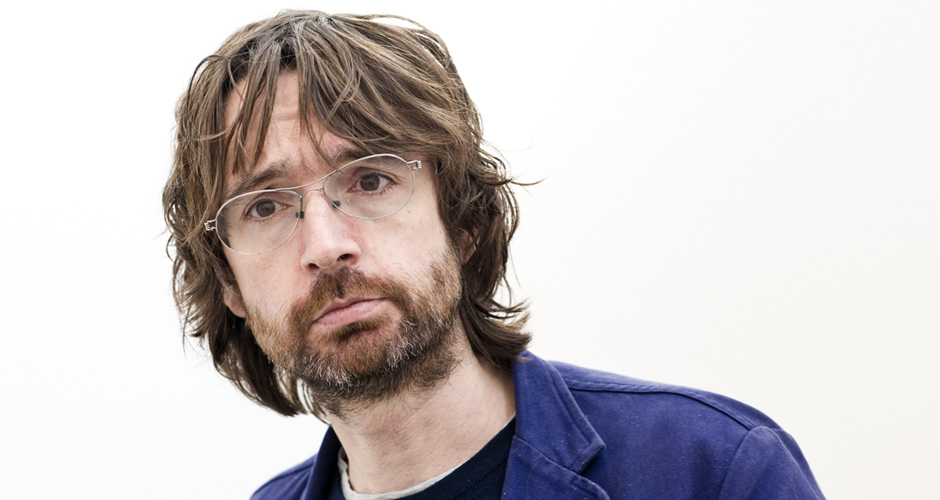Art has long propelled society forward by questioning the things that make it tick. Characterised by his curiosity for the world as it exists around him, artist Simon Starling approaches his work as an investigation into the connections between things. One of the most prominent examples of his practice is his 2005 Turner Prize-winning work Shedboatshed, for which Simon transformed a shed on the Rhine into a boat, sailed it down the river with leftover wood onboard, and then reassembled the shed. And while the shed now embodies its original form, its scars represent the journey. Simon’s latest exhibition, In Speculum, is at the Institute of Modern Art from October 5.
While some artists readily identify as painters, sculptors or photographers, conceptual artist Simon Starling has never limited his practice to a single form of art. Instead, his works begin with a question that he investigates using mediums ranging from photography to film and installation. When unravelled, his works interrogate the nature of being and the making of things a fundamental level.
These themes have been prevalent in Simon’s work since his early days as an artist, when his preoccupation with material forms began. For one of his first major works, Simon stripped the metal from an Eames chair and a Marin Sausalito bicycle, and reworked the metal from the chair to fit the bicycle and vice versa. Much the same as Shedboatshed, the final forms of the chair and bike are only slightly altered, but the process is what provides intellectual nourishment to the viewer.
“I suppose it’s a general kind of interest in trying to interrogate things, how they come to be in the world and where the materials for making them come from,” he explains of his approach to art.
Simon’s first inklings of becoming an artist came at the age of 11 when he developed an interest in photography. “It was like a revelation somehow to be in a dark room and watching a photographic print appear,” he recalls of creating his first photograph. “There was something completely magical about that moment and that was a trigger for a lot of things that came afterwards.”
With the memory of his first print implanted in his mind, Simon decided to study photography after school. But while learning the ins and outs of image making, he began to develop a curiosity for other art forms and took up the study of fine arts in Glasgow instead. He has since lived in many of Europe’s cultural hubs and – adhering to a philosophy that progress comes from always looking forward – says he’ll never live in a city twice.
He had already established himself in Europe when he was awarded the prestigious British Turner Prize in 2005, and admits it was gratifying to have his work acknowledged in such a context. “I hadn’t lived in England for a long time,” he recalls of winning the award. “So it was quite nice to be embraced by the mother country and acknowledged in that context. And it is amazing how it does have a global reach. People have heard of it or they know of it.”
He jokes that more people go to his talks since he won the prize but, on a fundamental level, he hasn’t let the accolade change his approach to art. And it’s this approach that Simon points to as his greatest achievement. “The thing I hold most dear in my work life is this sense that the art practice is still evolving and still developing,” he says. “I have always tried to push not to get stuck in a particular type of methodology or a particular way of working – not to depend on a particular sort of formal solution, but to really try and keep it moving and to keep questioning what I do.”
Maintaining this way of working hasn’t always been easy, and Simon admits that he still has moments when he struggles to reconcile the demands of work with those of his personal life. “Sometimes those things just don’t fit together and that’s always a challenge,” he explains. “What I do is I try to escape from the art world. I just shut the door, turn off the mobile phone and stop answering emails. It’s hard these days because it’s all-encompassing, but I get time to think.”
When Simon returns to work mode, however, his creative potential seems to have few limits. His latest exhibition In Speculum links together works from different points of his career. “It’s an exhibition that really focuses on different working spaces, on different forms of production,” Simon explains. “In a way it’s a simple mechanism to establish some new connections between a body of work that has developed over a long period.” Alongside some of his existing works, the exhibition also features a new photographic work based on the Great Melbourne Telescope.
When asked to share his words of wisdom, Simon reflects on his philosophy to keep moving. “I have a sense to keep my practice moving and changing and evolving, and it’s true of life as well,” he says. “It’s important to keep moving forward somehow.”
